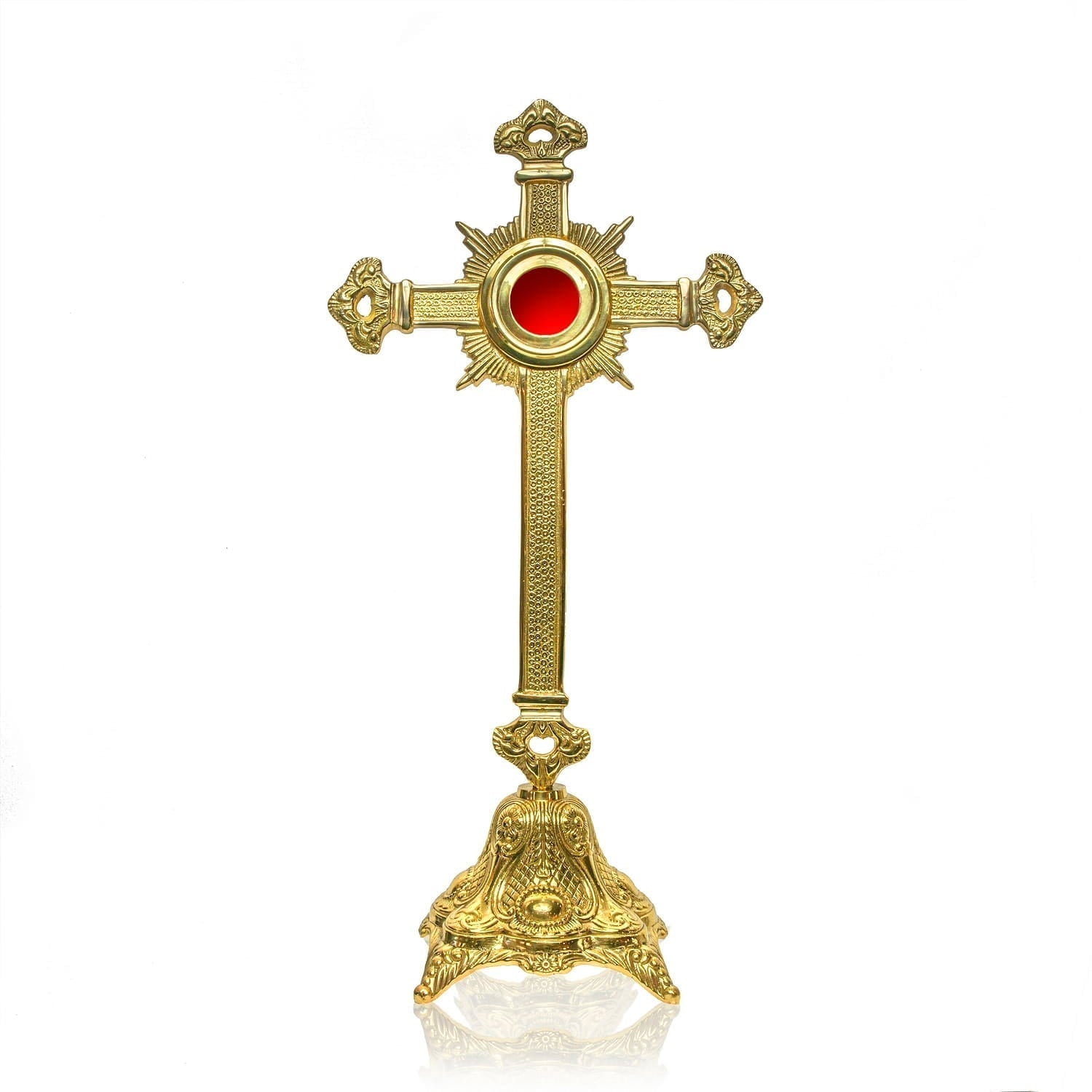Reliquaries
Reliquaries: Preserving Sacred Relics
What are Reliquaries?
Reliquaries are special containers designed to hold and display relics. Relics are objects of religious significance, often associated with saints, holy figures, or significant events in a religious tradition. These objects can include the physical remains of a saint (bones, hair, clothing), items that came into contact with a holy person, or objects associated with sacred events. Reliquaries serve not only as protective vessels but also as focal points for veneration and prayer.
The Purpose of Reliquaries
The primary purpose of a reliquary is to protect and preserve the relic it contains. Relics are considered sacred and deserving of reverence, so the reliquary is designed to prevent damage, decay, or desecration. Additionally, reliquaries serve to display the relic in a respectful and aesthetically pleasing manner, enhancing its significance and inspiring devotion among believers. They act as a tangible link to the past, connecting the faithful with the lives and legacies of those they hold in high regard.
History and Evolution of Reliquaries
The use of reliquaries dates back to the early centuries of Christianity, with evidence suggesting that Christians venerated the remains of martyrs and other holy individuals from the first and second centuries AD. Early reliquaries were simple containers, such as wooden boxes or cloth pouches, used to safeguard relics. As Christianity spread and became more established, the design and construction of reliquaries became more elaborate and ornate.
Early Reliquaries
In the early Church, relics were often kept in private homes or small chapels. The containers were typically simple and functional, reflecting the modest circumstances of the early Christian community. These early reliquaries were often made of wood, ivory, or metal and were designed to protect the relic from damage and decay.
Medieval Reliquaries
During the Middle Ages, the veneration of relics reached its height, and reliquaries became increasingly elaborate and ornate. Reliquaries were often crafted from precious metals such as gold and silver and adorned with gemstones, enamelwork, and intricate carvings. The design of medieval reliquaries often reflected the architectural styles of the period, with some resembling miniature cathedrals or tombs. These elaborate reliquaries were seen as fitting tributes to the saints and holy figures whose relics they contained.
Renaissance and Baroque Reliquaries
The Renaissance and Baroque periods saw further developments in the design and construction of reliquaries. Renaissance reliquaries often featured classical motifs and humanist themes, while Baroque reliquaries were characterized by their dramatic ornamentation and emotional intensity. Reliquaries from these periods often incorporated elements such as putti, scrolls, and elaborate floral designs. The use of precious materials and skilled craftsmanship continued to be a hallmark of reliquary production.
Types of Reliquaries
Reliquaries come in a wide variety of shapes, sizes, and styles, depending on the type of relic they contain, the period in which they were made, and the cultural context in which they were used. Some common types of reliquaries include:
- Arm Reliquaries: Shaped like an arm and hand, these reliquaries typically hold relics associated with the arm of a saint.
- Bust Reliquaries: Shaped like a bust of a person, these reliquaries often hold relics associated with the head or face of a saint.
- Cross Reliquaries: Shaped like a cross, these reliquaries typically hold fragments of the True Cross or other relics associated with the crucifixion of Jesus.
- Head Reliquaries: Designed to hold the skull or a fragment of the skull of a saint.
- Locket Reliquaries: Small, pendant-like containers worn around the neck, often holding small relics or fragments.
- Monstrance Reliquaries: Combining the functions of a monstrance and a reliquary, these vessels are used to display both the Eucharist and relics.
- Staurothèques: A specific type of reliquary designed to hold a fragment of the True Cross.
Materials Used in Reliquary Construction
Reliquaries have been made from a wide range of materials throughout history, reflecting the available resources and the artistic preferences of different cultures and periods. Some common materials used in reliquary construction include:
- Gold: A precious metal prized for its beauty, durability, and symbolic value.
- Silver: Another precious metal often used in reliquary construction, either alone or in combination with gold.
- Copper: A more affordable metal that can be gilded or plated to resemble gold or silver.
- Bronze: An alloy of copper and tin, often used for casting reliquary components.
- Ivory: A luxurious material derived from elephant tusks, often used for carving intricate details.
- Wood: A readily available material that can be carved, painted, or gilded.
- Glass: Used for creating transparent panels that allow the relic to be seen.
- Gemstones: Used to adorn reliquaries and enhance their visual appeal.
- Enamel: A decorative coating applied to metal surfaces, often used to create colorful designs.
The Significance of Reliquaries in Religious Practice
Reliquaries play a significant role in religious practice, serving as tangible reminders of the lives and legacies of saints and holy figures. They are often venerated as objects of devotion and are believed to possess healing powers or other miraculous properties. Reliquaries are often displayed in churches, cathedrals, and other sacred spaces, where they serve as focal points for prayer and contemplation.
Veneration of Relics
The veneration of relics is a common practice in many religious traditions, particularly in Christianity and Buddhism. Believers often touch or kiss reliquaries, or pray in their presence, seeking blessings, healing, or intercession from the saint or holy figure associated with the relic. The veneration of relics is seen as a way to connect with the divine and to draw closer to the saints and holy figures who serve as models of faith and virtue.
Reliquaries and Pilgrimage
Reliquaries are often the focus of pilgrimages, with believers traveling long distances to visit and venerate the relics they contain. Pilgrimage sites that house important reliquaries, such as the Shrine of the Three Kings in Cologne, Germany, or the Basilica of Saint Francis of Assisi in Italy, attract millions of visitors each year. These pilgrimages are seen as acts of devotion and penance, and pilgrims often seek spiritual renewal or healing through their contact with the relics.
Collecting Reliquaries
Collecting reliquaries can be a fascinating and rewarding hobby, offering insights into religious history, art, and culture. However, it is important to approach reliquary collecting with respect and sensitivity, recognizing the sacred nature of these objects and the religious beliefs they represent. Collectors should also be aware of legal and ethical considerations related to the acquisition and ownership of reliquaries.
Ethical Considerations
It is essential to ensure that any reliquary acquired for a collection has been obtained legally and ethically. Collectors should avoid purchasing reliquaries that have been stolen, looted, or illegally exported from their country of origin. Additionally, collectors should respect the religious significance of reliquaries and avoid displaying them in a manner that is disrespectful or offensive to believers.
Authenticity and Provenance
Determining the authenticity and provenance of a reliquary can be challenging, as many reliquaries have been altered, repaired, or reattributed over time. Collectors should seek the advice of experts and consult scholarly resources to verify the authenticity and provenance of any reliquary they are considering purchasing. Documentation such as certificates of authenticity, historical records, and provenance information can help to establish the legitimacy of a reliquary.
Reliquaries in the Modern World
While the veneration of relics may seem like an ancient practice, reliquaries continue to play a role in religious life today. Many churches and cathedrals still display reliquaries containing the remains or personal items of saints, and pilgrimages to reliquary sites remain popular. In addition, reliquaries have become objects of interest for art historians, collectors, and scholars, who study them for their historical, artistic, and cultural significance.
Reliquaries as Art Objects
Reliquaries are often considered works of art in their own right, showcasing the skill and craftsmanship of the artisans who created them. The intricate designs, precious materials, and symbolic imagery found in reliquaries reflect the artistic styles and religious beliefs of the cultures in which they were made. Museums and galleries around the world display reliquaries as examples of religious art and cultural heritage.
The Future of Reliquaries
As long as religious traditions continue to venerate relics, reliquaries will remain relevant as objects of devotion and cultural significance. Whether displayed in churches, museums, or private collections, reliquaries serve as tangible links to the past, reminding us of the lives and legacies of those who have inspired faith and devotion throughout history. Their preservation and study will continue to enrich our understanding of religious art, history, and culture.
Conclusion
Reliquaries are more than just containers they are sacred vessels that protect and display relics, objects of profound religious significance. Throughout history, these containers have evolved from simple boxes to elaborate works of art, reflecting the changing artistic styles and religious beliefs of different cultures. Whether venerated as objects of devotion or studied as examples of cultural heritage, reliquaries offer a unique window into the world of religious practice and belief.




